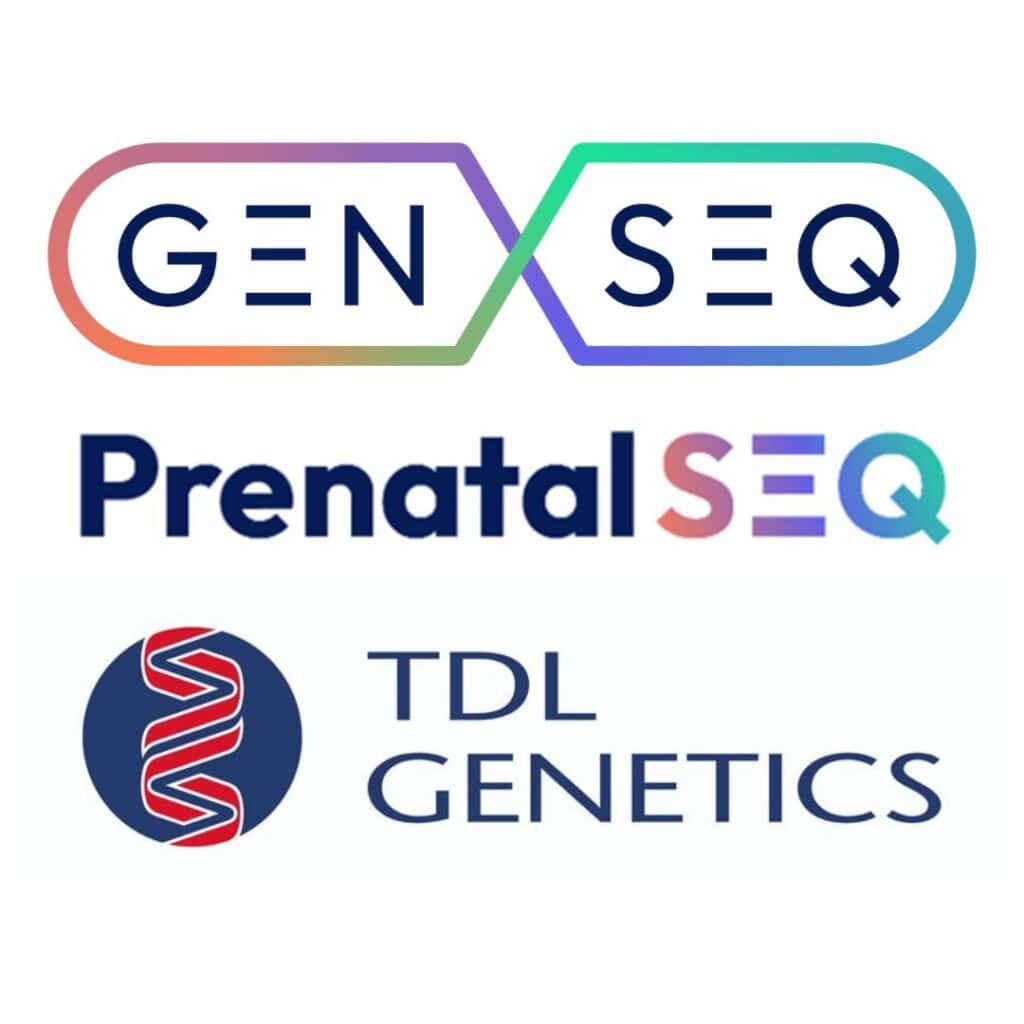PrenatalSEQ Test
Genetic testing during pregnancy
Non-invasive prenatal testing (NIPT) screens for the presence of specific chromosome disorders in the developing fetus. The test analyses fragments of DNA in maternal plasma that have been released from both maternal and placental cells.
NIPT requires a single blood draw, which poses no threat to the fetus, and can be done as early as 10 weeks’ gestation. By analysing the proportions of DNA fragments derived from different chromosomes or chromosome regions, NIPT can screen for the presence or absence of specific chromosome disorders.
NIPT is more accurate than first trimester maternal serum screening and ultrasound in identifying pregnancies with or without these disorders.


What can PrenatalSEQ tell me?
- Trisomy 21 (Down syndrome)
- Trisomy 18 (Edwards Syndrome)
- Trisomy 13 (Patau Syndrome)
- Sex Chromosomal Disorders (Optional)
- Fetal Sex Determination (Optional)
Testing Detail
- Turnaround Time: 3 to 5 Working Days*
- Gestational Age: 10 weeks
Working Days* – From Receipt at Lab
About PrenatalSEQ Test
DNA from the fetus circulates in the mother’s blood. Cell-free DNA (cfDNA) results from the natural breakdown of fetal cells (presumed to be mostly placental) and clears from the maternal system within hours of giving birth.
During a pregnancy, cfDNA can be tested to give the most accurate screening approach in estimating the risk of a fetus having a common chromosome condition sometimes called a trisomy. This occurs when there are three copies of a particular chromosome instead of the expected two. The test looks to detect the following conditions:
- Trisomy 21 is the most common trisomy at the time of birth. Also called Down syndrome, it is associated with moderate to severe intellectual disabilities and may also lead to digestive disease, congenital heart defects and other malformations.
- Trisomy 18 (Edwards syndrome) and Trisomy 13 (Patau syndrome) are associated with a high rate of miscarriage. These babies are born with severe brain abnormalities and often have congenital heart defects as well as other birth defects. Most affected individuals die before or soon after birth, and very few survive beyond the first year of life.
- Sex chromosome conditions occur when there is a missing, extra, or incomplete copy of the X or Y chromosomes. The NIPT test with sex chromosome aneuploidy panel option can assess risk for XXX, XYY, XXY (Klinefelter syndrome), and a missing X chromosome in a girl (Turner syndrome).
In addition, NIPT can assess fetal sex. This is optional (no additional cost).
NIPT does not screen for non-chromosome disorders, familial mutations, malformations, fetal growth or fetal viability.
Risk
The testing is non-invasive: it involves taking a blood sample from the mother. The pregnancy is not put at risk of miscarriage, or from other adverse outcomes that are associated with invasive testing procedures such as amniocentesis.
Accuracy
NIPT provides fewer false-positive and false-negative results than combined first trimester screening for trisomy 21, 18 and 13.
It is important to note that NIPT is a screening test and does not provide a definitive genetic diagnosis, as NIPT cannot differentiate potential chromosome differences between the placenta and fetus. A definitive genetic diagnosis of the fetus requires cytogenetic analysis of either amniotic fluid or chorionic villus sampling (CVS).
Who can have the test?
NIPT can be ordered by healthcare professionals for women with pregnancies of at least 10 weeks’ gestational age. This test can be requested for any singleton or twin pregnancy, including those conceived naturally or by IVF using the patient’s own egg or a donor egg.
Note that, in twin pregnancies, sex chromosome (X and Y) analysis can determine fetal sex but not sex chromosome conditions. This test is not suitable in the case of a vanishing twin. The sex of twins will be reported as one result. If male, one or both of the twins will be male. If female, both twins will be female.
The test does not assess risk for mosaicism, partial trisomies or translocations.

Limitations of NIPT
The VeriSeq NIPT Solution v2 is not validated for use in pregnancies with more than two fetuses, fetal demise, mosaicism, partial chromosome aneuploidy, triploidy, translocations, maternal aneuploidy, transplant or malignancy. VeriSeq NIPT Solution v2 does not detect neural tube defects. Certain rare biological conditions may also affect the accuracy of the test.
For twin pregnancies, HIGH PROBABILITY test results apply to at least one fetus; male test results apply to one or both fetuses; female test results apply to both fetuses. Due to the limitations of the test, inaccurate results are possible.
A LOW PROBABILITY result does not guarantee that a fetus is unaffected by a chromosomal or genetic condition. Some non-aneuploid fetuses may have HIGH PROBABILITY results. In cases of HIGH PROBABILITY results and/or other clinical indications of a chromosomal condition, confirmatory testing is necessary for diagnosis.
Results
Results will be ready in approximately 3–5 working days. Women still can have their 12-week scan for a detailed examination of the fetal anatomy, including measurement of nuchal translucency, nasal bone and other important factors. In this visit, patients can discuss the DNA and ultrasound results with their obstetricians.
On the basis of the NIPT result and the ultrasound findings, a patient can decide whether or not she wants to have an invasive procedure (for example, CVS or amniocentesis).
VeriSeq Test
VeriSeq screens for chromosomal abnormalities in a developing fetus during pregnancy

VeriSeq screens for chromosomal abnormalities in a developing fetus during pregnancy.
The VeriSeq Test screens for the detection of:
- Trisomy 21 (Down syndrome)
- Trisomy 18 (Edwards syndrome)
- Trisomy 13 (Patau syndrome)
- Sex Chromosomal Disorders (Optional)
- Fetal Sex Determination (Optional)

What can VeriSeq tell me?
VeriSeq is a Non-invasive Prenatal Test (NIPT) that screens for chromosomal abnormalities in a developing fetus during pregnancy. VeriSeq is available as early as 10 weeks gestation and requires just a single blood draw from the pregnant patient. VeriSeq is a screening test and must not be used as the sole basis for diagnosis or other pregnancy management decisions.
Veriseq screens for three common chromosomal abnormalities:
- Trisomy 21 (Down syndrome)
- Trisomy 18 (Edwards Syndrome)
- Trisomy 13 (Patau Syndrome)
Optionally, VeriSeq also screens for certain sex chromosomes abnormalities:
- Monosomy X (Turner Syndrome)
- XXX Syndrome (Triple X Syndrome)
- XXY Syndrome (Klinefelter syndrome)
- XYY Syndrome (Jacob’s Syndrome)
You will also have the option to find out the sex of the fetus.

Testing Detail
- Turnaround Time: 2 to 5 Working Days
- Gestational Age: 10 weeks
About VeriSeq Test
DNA from the fetus circulates in the mother’s blood. Cell-free DNA (cfDNA) results from the natural breakdown of fetal cells (presumed to be mostly placental) and clears from the maternal system within hours of giving birth.
During a pregnancy, cfDNA can be tested to give the most accurate screening approach in estimating the risk of a fetus having a common chromosome condition sometimes called a trisomy. This occurs when there are three copies of a particular chromosome instead of the expected two. The test looks to detect the following conditions:
- Trisomy 21 is the most common trisomy at the time of birth. Also called Down syndrome, it is associated with moderate to severe intellectual disabilities and may also lead to digestive disease, congenital heart defects and other malformations.
- Trisomy 18 (Edwards syndrome) and Trisomy 13 (Patau syndrome) are associated with a high rate of miscarriage. These babies are born with severe brain abnormalities and often have congenital heart defects as well as other birth defects. Most affected individuals die before or soon after birth, and very few survive beyond the first year of life.
- Sex chromosome conditions occur when there is a missing, extra, or incomplete copy of the X or Y chromosomes. The NIPT test with sex chromosome aneuploidy panel option can assess risk for XXX, XYY, XXY (Klinefelter syndrome), and a missing X chromosome in a girl (Turner syndrome).
In addition, NIPT can assess fetal sex. This is optional (no additional cost).
NIPT does not screen for non-chromosome disorders, familial mutations, malformations, fetal growth or fetal viability.
Risk
The testing is non-invasive: it involves taking a blood sample from the mother. The pregnancy is not put at risk of miscarriage, or from other adverse outcomes that are associated with invasive testing procedures such as amniocentesis.
Accuracy
NIPT provides fewer false-positive and false-negative results than combined first trimester screening for trisomy 21, 18 and 13.
It is important to note that NIPT is a screening test and does not provide a definitive genetic diagnosis, as NIPT cannot differentiate potential chromosome differences between the placenta and fetus. A definitive genetic diagnosis of the fetus requires cytogenetic analysis of either amniotic fluid or chorionic villus sampling (CVS).
Who can have the test?
NIPT can be ordered by healthcare professionals for women with pregnancies of at least 10 weeks’ gestational age. This test can be requested for any singleton or twin pregnancy, including those conceived naturally or by IVF using the patient’s own egg or a donor egg.
Note that, in twin pregnancies, sex chromosome (X and Y) analysis can determine fetal sex but not sex chromosome conditions. This test is not suitable in the case of a vanishing twin. The sex of twins will be reported as one result. If male, one or both of the twins will be male. If female, both twins will be female.
The test does not assess risk for mosaicism, partial trisomies or translocations.

Limitations of NIPT
The VeriSeq NIPT Solution v2 is not validated for use in pregnancies with more than two fetuses, fetal demise, mosaicism, partial chromosome aneuploidy, triploidy, translocations, maternal aneuploidy, transplant or malignancy. VeriSeq NIPT Solution v2 does not detect neural tube defects. Certain rare biological conditions may also affect the accuracy of the test.
For twin pregnancies, HIGH PROBABILITY test results apply to at least one fetus; male test results apply to one or both fetuses; female test results apply to both fetuses. Due to the limitations of the test, inaccurate results are possible.
A LOW PROBABILITY result does not guarantee that a fetus is unaffected by a chromosomal or genetic condition. Some non-aneuploid fetuses may have HIGH PROBABILITY results. In cases of HIGH PROBABILITY results and/or other clinical indications of a chromosomal condition, confirmatory testing is necessary for diagnosis.
Results
Results will be ready in approximately 2–5 days. Women still can have their 12-week scan for a detailed examination of the fetal anatomy, including measurement of nuchal translucency, nasal bone and other important factors. In this visit, patients can discuss the DNA and ultrasound results with their obstetricians.
On the basis of the NIPT result and the ultrasound findings, a patient can decide whether or not she wants to have an invasive procedure (for example, CVS or amniocentesis).

